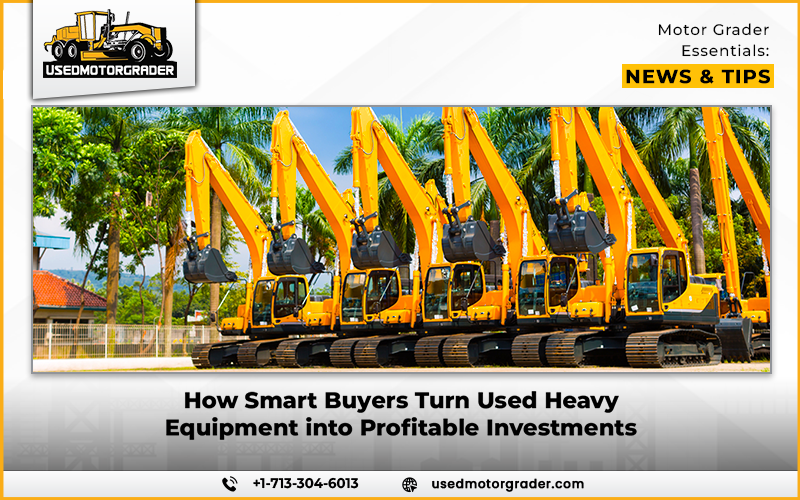From Auction to Asset
Because the construction and earthmoving industries are so demanding, buying used heavy equipment has turned into a way to improve a business strategy, not just save money. Because project margins are narrow and lead times are short, getting quality machines at discounts can help contractors grow their business rapidly. Nevertheless, some used machines fail to perform well. A few develop into big issues that burn up time and money. Often, the difference between a smart buy and one you regret is decided long before the machine is delivered.
Opportunities in the Used Market
There is a healthy market for used heavy equipment, so buyers can purchase good machines without losing value as soon as the machine is driven off the lot. In this setting, contractors have a good chance, especially when they must meet seasonal demand, quickly replace a broken machine, or want to grow without taking on big debt. But just because something is used doesn’t always mean it’s valuable. The different machines we have show a wide range in how worn they are, how long they have been used, and how reliable they are. That’s why savvy buyers analyze more than just the purchase price; they also consider how the equipment will work in their company now and in the future.
Knowing What You Really Need and Why That Matters
People who want to buy smartly should make sure they know exactly what they are looking for before looking at inventories or bidding. It also means checking the engine size, what it can lift, how much pressure it puts on the ground, the tools available, and how it will be transported. Wanting a bigger or fancier machine can be tempting, but blowing your budget on extra features you don’t need can take away from your return on investment. Similarly, if you don’t accurately estimate your requirements, the unit may not perform well at the project site. When buyers pick the right tool for the job, they ensure their money and their work rate are well protected.
Pre-Purchase Inspections That Go Beyond Surface Appearances
What you see on the outside might look good, but real buyers know the important stuff is under the hood. Buying used heavy equipment becomes most profitable after a full inspection that includes looking for leaks, studying the wear, checking maintenance records, and checking for any errors or performance readings. A visit is best, but online buyers should make sure to get plenty of photos and videos of the property. A seller who is against being transparent or doesn’t want the product inspected should make you suspicious. Taking time to inspect the car before buying helps you avoid having to repair it soon after.
Pricing Strategies: When a Bargain Is Too Good to Be True
The urge to buy low is strong in crowded auction markets. Experienced buyers know what they want from the start.
They evaluate the machine’s current value, review recent sale prices for the same model. Factor in repair costs, transportation, and downtime in their calculations.
A “deal” is not simply about the money you pay, it’s about receiving something worth your investment. A machine that needs a lot of repair or will not run because of missing parts can eventually become more costly. Wise buyers match up the cost of the vehicle with its condition, what it can do, and what it might need in the future.
Planning for Resale Before You Even Buy
Many people forget that planning for a resale is an important part of making a profitable buy. Buying a business can seem like the only priority, but great buyers have a plan for what they’ll do when they sell. There are brands and types of cars that appreciate better than others. Clean and properly maintained machines with very few hours sold will usually sell ahead of others and for more. Even the most basic things, such as organizing operator manuals and service logs, can help you later. If you think about resale from the start, it becomes easier to recoup the funds you’ve invested.
Putting It to Work: Usage Forecasting and Project Fit
Once you have the machine, it has to be useful and make sense for you to own. Projecting equipment usage lets buyers compare the expense of the machines with their benefits over time. Standing machines in the yard for a long time are a waste of potential.
Failing to properly maintain a unit over time can cause it to wear out and break down sooner. Scheduling machine use according to the project timeline helps keep the cost-per-hour low.
It helps with planning ahead, being able to remove a machine from production before it becomes less valuable.
Maintenance as Investment Protection
When a used machine runs well, performs as needed, and keeps its value, it becomes a profitable asset. All of this is dependent on good maintenance. Maintaining your home doesn’t have to be optional, it’s important. Machines deliver the most valuable results when operators regularly maintain them with fluid. Also, filter changes, inspection of tires and tracks, and running diagnostics. Following a regular service schedule will help your machine work well for years and fetch a greater price when resold.
Buyers usually enjoy greater returns on their purchases when they treat maintenance as an important expense from the start.
Ultimately
It’s about picking a machine that will help your business in the long term. The secret to getting value from an acquisition is to be clear about your needs. Inspect everything closely, act disciplined with your budget, consider reselling, and always keep the machine well-maintained. Handled wisely, the equipment you get second-hand can boost your revenue and enhance the overall efficiency of your business. Contractors who achieve the best results are asset managers, realizing that performance over the machine’s life is more important than its original cost.


